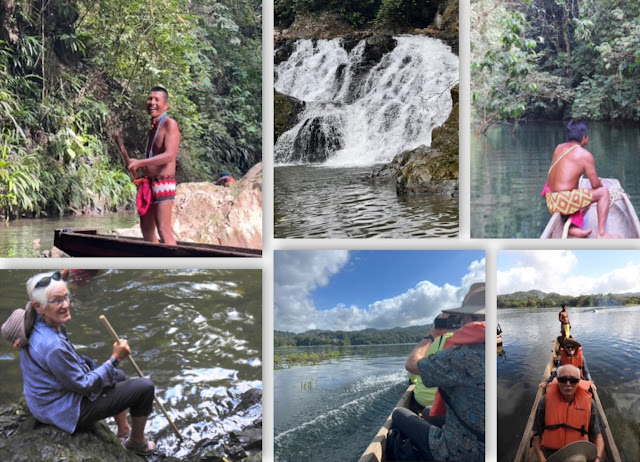An early flight got us to the David airport. After a 45 minute drive we arrived in Boquete and checked in to our accommodations at Villa Alejandro. Boquete has a large expat population, as does Cuenca (Ecuador) and San Miguel. Honestly we were curious what we would think of the competition. For us, San Miguel is the clear winner for it's easy walkability and compact urban center. The others are nice places to visit.
We were introduced to the Bajareque upon arrival in Boquete. Anytime during the day there may be what is defined as a fine drizzle but it is more like someone was spraying the area from above with an extremely fine mist. And it comes and goes. You learn to just ignore it. No need for an umbrella.The source of the Bajareque seems to be the fog that comes and goes on the nearby mountains.
We went to lunch at the nearby Valle de Cuzco, yes a Peruvian Restaurant. Hence the picture of Bill in front of Machu Picchu. Pat really enjoyed her Shrimp & Mushrooms dish. A very fine culinary experience.
Our afternoon introductory tour of the area took us around the city and out to Los Ladrilles, a lateral columnar basalt wall, a great draw for rock climbers. A little further up the road we stopped to appreciate a small water fall. We finished the tour with a local coffee - cappuccino for Bill and frappuccino for Pat. We wanted a light evening meal and chose Vale! Tapas y Mas for dinner. Under new management the menu did not life up to the Tapas and More name. We asked about what might be available and found that they had a nice tapas plate for two (Not listed on the menu. Go figure.)
There were also some interesting flora including a tree that had fallen down and was a great example of trees without rings. There are no seasons or dormant periods here causing rings to form.
The tour also included visiting Finca Lerida coffee plantation with lunch and a tour of the processing area.
Key processing steps include separating the bean from the cherry (hullling), screening the beans for size, and grading the beans. The main methods used here are the Washed or wet process and the Natural sun dried or dry process. Apparently these two techniques affect mouthfeel and flavor in many ways. Most of the coffee that people drink is washed or wet-processed coffee. The Wet method is more consistent and used for producing coffee with higher acidity (for rich lush taste). In the Dry method, the coffee beans absorb the character of the drying flesh of the fruit. For the Dry method, the coffee cherries are dried in the open air and can take weeks to dry. Long strips of beans are spread out on large concrete patios. The workers rake them around 3-4 times per hour to avoid spoilage. They also produce some coffees using the Honey method which leaves some of the pulp on the beans resulting in a sweeter flavor.
They raise Geisha and Catuai coffees. Geisha coffee originated in Ethiopia but is now a major product of Panama. Due to its fruity character, it is highly valued and one of the most expensive in the world.
At the end of the tour we had a tasting of 4 coffees (representing three processing styles and two types of beans) followed by another coffee and dessert. We returned to Villa Alejandro and our usual evening wine and snack.
Next day we had no formal tours so explored the town. First we crossed the river to preview the Flower, Coffee and Craft Festival (scheduled to open that evening). We also visited Felipe Motta Wine Store & Deli to checkout the selection (quite satisfactory). Later we headed to Mikes Global Grille for lunch. We opted for the pea soup with burgers. We returned to the Felipe Motta Wine Store & Deli for some wine and snacks for our evening meal. Our second tour day had the 3 Falls hike on tap. We only saw two of the three falls, the trail to number three was steep, rough and slippery. Our guide told us that seeing two was most common and that number 2 was the best. On our return to the car our guide spotted a sloth in the trees near the trail. No need to rush photos with a sloth. The difficulty here is they hide in the leaves and move very slowly making it difficult to find them.Upon returning to Boquete we went to the Fish House for lunch. We both chose talapia with different preparations. Later we headed back across the river for a full tour of the Flower, Coffee and Crafts Festival. Quite impressive displays and many booths selling plants and many Fresas Café's selling strawberries (fresa in Spanish) with a wide range of toppings.On our last day in Boquete we explored more of the town across the river. We had lunch at Retrogusto, stuffed mushrooms followed by pasta and risotto. Highly recommend. Another visit to the wine shop for evening snacks and it was time to pack.Next morning we were transferred back to David and after a short wait we were on our way to Panama City where we connected to our flight to Mexico City. We had a long wait (~1.5 hrs) at immigration in Terminal 2, a very large crowd of people. We finally arrived home around 8PM.






























